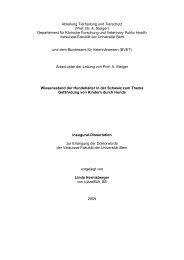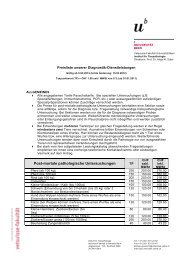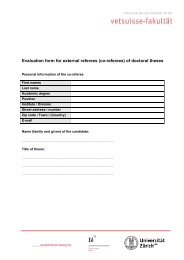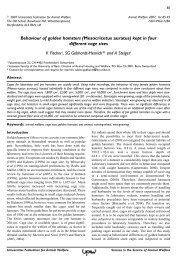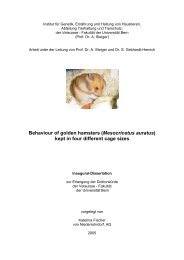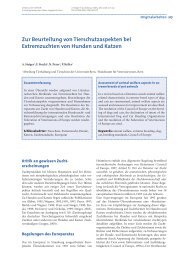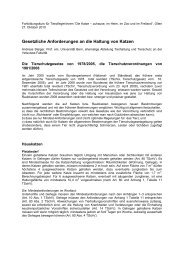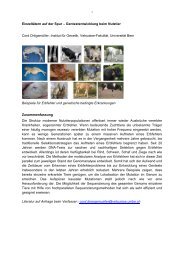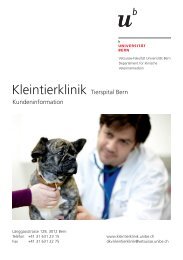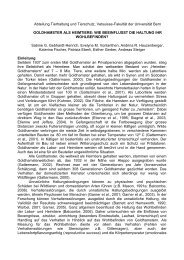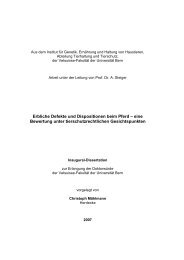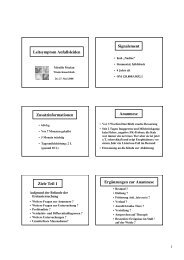Lifespan and Causes of Death in the Irish Wolfhound - Vetsuisse ...
Lifespan and Causes of Death in the Irish Wolfhound - Vetsuisse ...
Lifespan and Causes of Death in the Irish Wolfhound - Vetsuisse ...
You also want an ePaper? Increase the reach of your titles
YUMPU automatically turns print PDFs into web optimized ePapers that Google loves.
veter<strong>in</strong>ary lifespan studies goes beyond <strong>the</strong> scope <strong>of</strong> this <strong>the</strong>sis. For more<br />
<strong>in</strong>formation on <strong>the</strong> topic, consult Urfer (2007, <strong>in</strong> prep)<br />
7.1.3 Differences <strong>in</strong> Previous Studies' Results<br />
When compar<strong>in</strong>g lifespan calculated from <strong>the</strong> data <strong>of</strong> <strong>the</strong> previously published<br />
studies, highly significant differences can be observed between <strong>the</strong> North American<br />
(Bernardi 1986; Prokopenko 1998) <strong>and</strong> <strong>the</strong> Anglo-<strong>Irish</strong> dogs (Murphy 1991), <strong>the</strong> latter<br />
liv<strong>in</strong>g on average 1.4 years longer than <strong>the</strong>ir North American counterparts.<br />
There are several potential <strong>in</strong>terpretations <strong>of</strong> <strong>the</strong>se differences. Obviously, it is<br />
possible that <strong>Irish</strong> <strong>Wolfhound</strong>s <strong>in</strong> Irel<strong>and</strong> <strong>and</strong> Great Brita<strong>in</strong> have a higher life<br />
expectancy than <strong>Irish</strong> <strong>Wolfhound</strong>s <strong>in</strong> North America. Although <strong>the</strong> populations are<br />
genetically close (see chapter 6.3), <strong>the</strong> relative isolation due to quarant<strong>in</strong>e laws that<br />
existed <strong>in</strong> Irel<strong>and</strong> ant <strong>the</strong> UK dur<strong>in</strong>g <strong>the</strong> study period may have favoured different<br />
developments <strong>in</strong> this population. The importance <strong>of</strong> country class <strong>in</strong> <strong>the</strong> General<br />
L<strong>in</strong>ear Model used for <strong>the</strong> author's data may also be <strong>in</strong>dicative <strong>of</strong> this hypo<strong>the</strong>sis.<br />
The distribution <strong>of</strong> birth cohorts <strong>in</strong> <strong>the</strong> two datasets varies: While Bernardi's <strong>and</strong><br />
Prokopenko's data only conta<strong>in</strong> 6.27% <strong>of</strong> dogs born before 1965, Murphy (1991)<br />
conta<strong>in</strong>s 14.04% <strong>of</strong> such dogs. S<strong>in</strong>ce it could be shown <strong>in</strong> <strong>the</strong> present study that <strong>Irish</strong><br />
<strong>Wolfhound</strong>s lived longer <strong>in</strong> <strong>the</strong> 1960s than <strong>the</strong>y did later on, this may also have had<br />
an <strong>in</strong>fluence on <strong>the</strong>se differences.<br />
It is also possible that Murphy (1991) was more <strong>in</strong>fluenced by submitter's bias (see<br />
chapter 3.1.1.1) than were Bernardi (1986) <strong>and</strong> Prokopenko (1998): The former drew<br />
its data almost exclusively from breeders, who may have been more motivated to<br />
submit older dogs than to submit those that died young. On <strong>the</strong> o<strong>the</strong>r h<strong>and</strong>, <strong>the</strong> North<br />
American studies also <strong>in</strong>cluded data contributed by important numbers pet owners,<br />
who may have had fewer <strong>in</strong>terests <strong>in</strong> promot<strong>in</strong>g a particular kennel or family.<br />
These same demographics could also have contributed to <strong>the</strong> measured lifespan<br />
through ano<strong>the</strong>r mechanism: It could be assumed that people runn<strong>in</strong>g a breed<strong>in</strong>g<br />
kennel may be more educated <strong>in</strong> veter<strong>in</strong>ary medic<strong>in</strong>e than <strong>the</strong> average dog owner,<br />
which may lead to an <strong>in</strong>crease <strong>in</strong> life expectancy <strong>in</strong> <strong>the</strong>ir dogs.<br />
7.1.4 Gender <strong>and</strong> Castration Effects<br />
The data used <strong>in</strong> this study unanimously suggest that female <strong>Irish</strong> <strong>Wolfhound</strong>s on<br />
average have a longer lifespan than do males (chapters 5.1.5, 5.2.1.3 <strong>and</strong> 6.2.4).<br />
While little data have been published about gender effects on lifespan <strong>in</strong> dogs, this<br />
mirrors <strong>the</strong> situation <strong>in</strong> humans. It is possible that <strong>the</strong> shorter life expectancy <strong>in</strong> males<br />
may also be mediated through <strong>the</strong>ir larger size to a certa<strong>in</strong> extent.<br />
A gender predisposition <strong>of</strong> male <strong>Irish</strong> <strong>Wolfhound</strong>s to Dilatative Cardiomyopathy has<br />
been described <strong>in</strong> numerous studies (see chapter 3.3.2) <strong>and</strong> was also reproduced <strong>in</strong><br />
<strong>the</strong> study at h<strong>and</strong> (see chapters 5.1.5 <strong>and</strong> 6.2.4), thus fur<strong>the</strong>r support<strong>in</strong>g <strong>the</strong><br />
hypo<strong>the</strong>sis that a sex predisposition for this disease exists <strong>in</strong> <strong>the</strong> breed.<br />
The predisposition <strong>of</strong> female <strong>Irish</strong> <strong>Wolfhound</strong>s to death by cancers o<strong>the</strong>r than<br />
Osteosarcoma has not been described <strong>in</strong> <strong>the</strong> literature beforeh<strong>and</strong>. However, <strong>the</strong><br />
92



